Breaking down the basics of how to make homemade milk kefir, a probiotic-rich fermented drink that’s soon to be a staple in your kitchen!
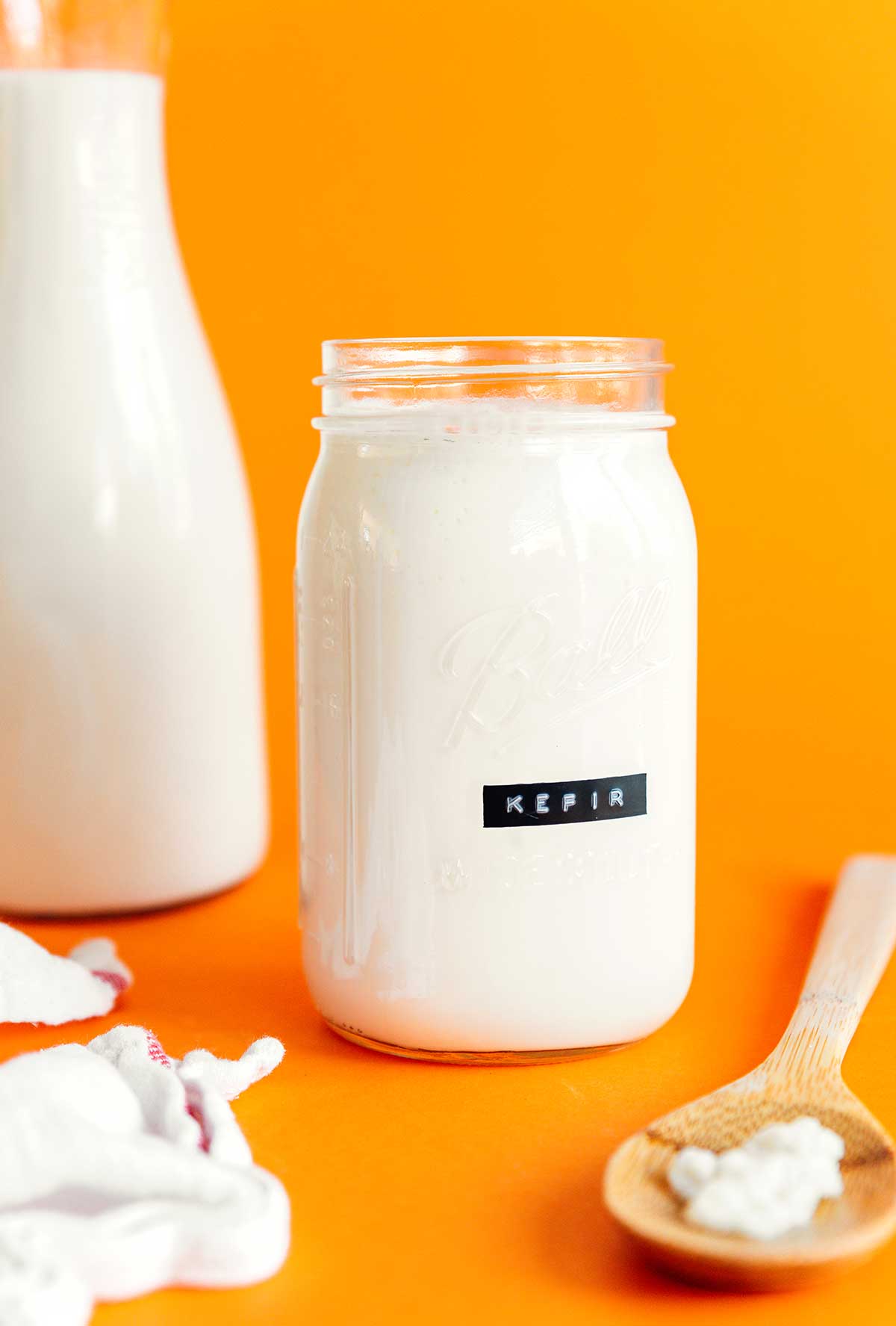
After having delicious success with kombucha (one of the most popular recipes on the blog!), I got to thinking about what other tasty fermented things we could brew up at home. And over the course of a day I went from not having a clue how kefir worked to biking across town to buy my very first kefir grains from a passionate home brewer.
I spent the next few weeks getting to know my new kefir baby. Our relationship was first that of fear. When I wasn’t scared of killing it, I was scared of drinking it. But after a few days I started to get the hang of what it needed (and oh my the way, it started to turn out some delicious kefir!).
So after fermenting hundreds of batches of kefir at home, I’m excited to share with you the secrets to seriously delicious, creamy, homemade kefir. Click the links below to jump around the post, or scroll on to dive into the world of homemade kefir!
- What is kefir 🥛
- Kefir grains (and where to get them) 🧐
- Best milk for kefir 🐮
- Kefir FAQ 👩🏫
- Step-by-Step Instructions 📝
How to Make Milk Kefir Video
Reader rating
“Thank you Sarah for the detailed and easy to follow guidelines for making milk Kefir. I just bought milk Kefir grains from a local gal and started my Kefir this morning with raw whole goats milk.” —Marita
What is kefir?
For the unfamiliar, kefir is a thick, fermented milk drink. It tastes a bit like plain Greek yogurt – slightly sour and ultra-creamy. But even more so than most types of yogurt, kefir is jam-packed with all kinds of gut-friendly probiotics!
So if you’re curious about kefir or looking for a fun summer project, try giving kefir a go! Let’s get into the nitty gritty.
What are kefir grains?
To start off this kef-venture, you’ll need to get your hands on some kefir grains. Kefir “grains” are the engine of this whole process, containing all the yeasts and bacteria needed to ferment the milk into creamy kefir. (The gluten-free folks don’t need to worry – these aren’t true grains, but rather rubbery, cellular structures).
They’re like what the SCOBY is to kombucha, only instead of looking like alien pancakes they look like cauliflower! But unlike kombucha, you cannot grow your own kefir grains and will need to acquire them somewhere.
Where do you get kefir grains? Unless you have a friend who makes kefir, it’s easiest to get your grains online. You can find them on Amazon here.
Once you have your kefir grains, you won’t have to buy them again. They will grow and continue to ferment many batches of kefir.
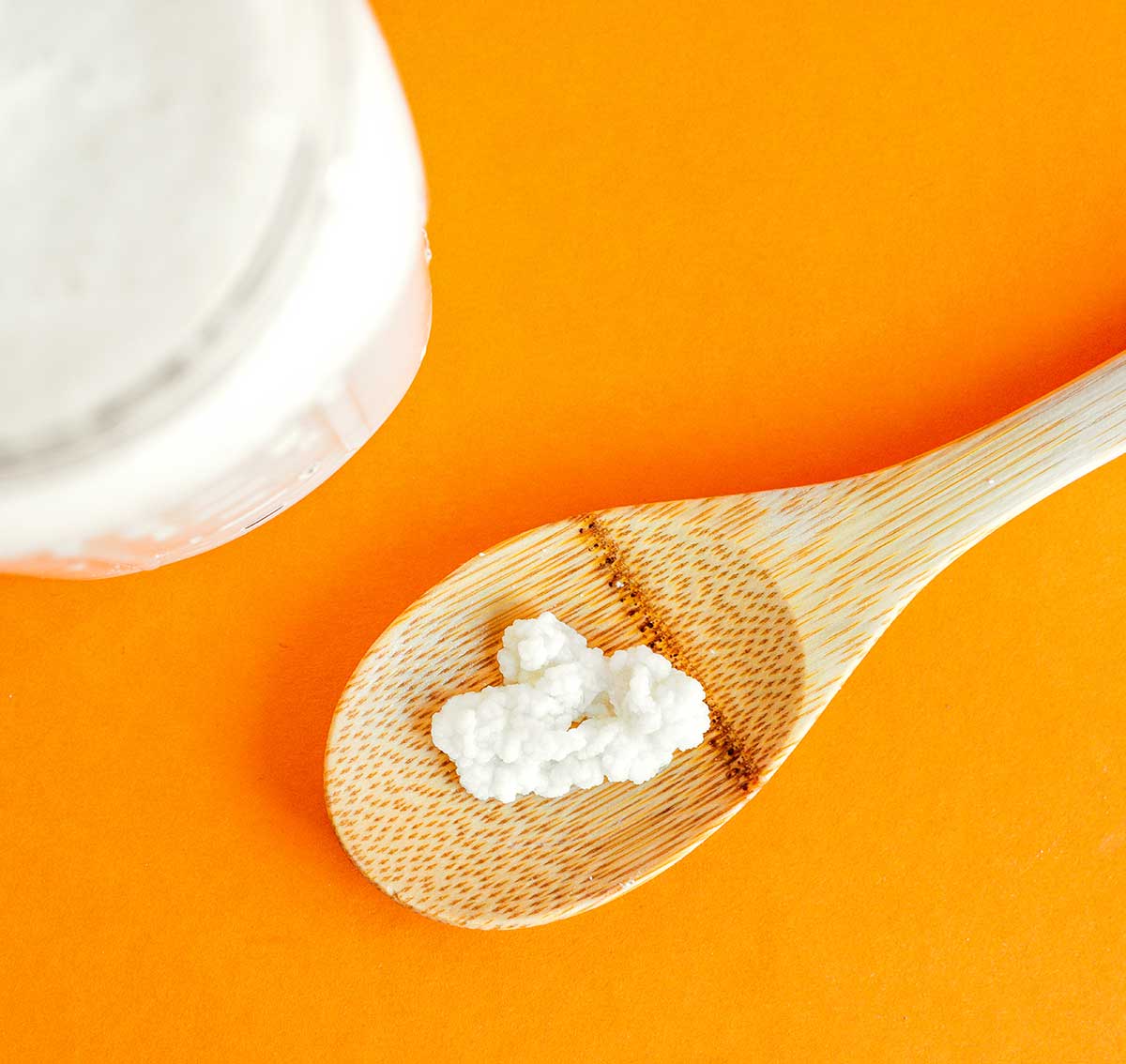
The best milk for making kefir
The only other ingredient besides kefir grains in this recipe is the milk! You’ll want to use pasteurized milk to start, but can switch to raw milk slowly after a few weeks of getting your kefir grains used to their new environment.
In terms of fat level, the grains will be a lot happier in whole milk, though you can slowly transition to a lower fat option over time.
And finally, though you can use cow’s or goat’s milk, though I’ve only had experience with whole cow’s milk for making kefir.
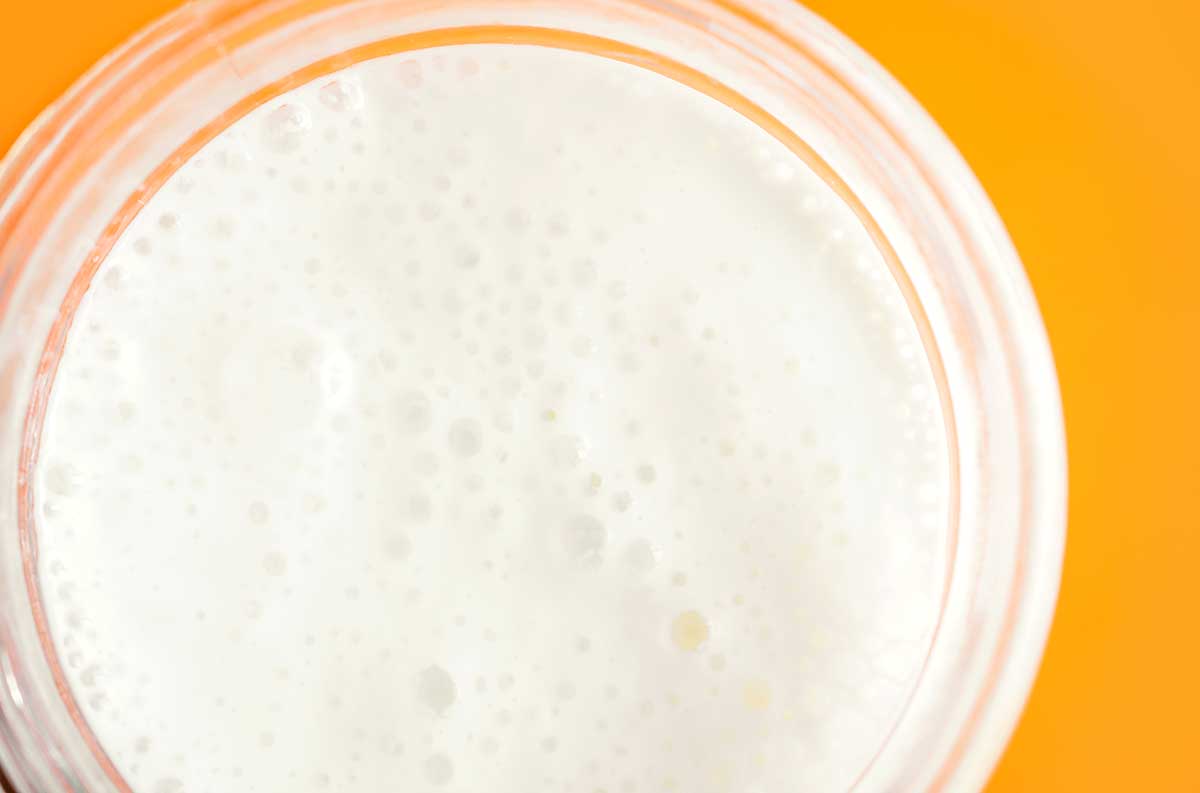
Supplies needed to make kefir
While making kefir is easy and doesn’t require specialized equipment, you’ll need a handful of common kitchen supplies to make kefir.
- Large(ish) glass or ceramic jug (at least 5 cup capacity)
- Non-metal slotted spoon
- Fine woven cloth, paper towels, or coffee filters
- Wide non-metal bowl
- Fine non-metal colander
- Jar for storing finished kefir
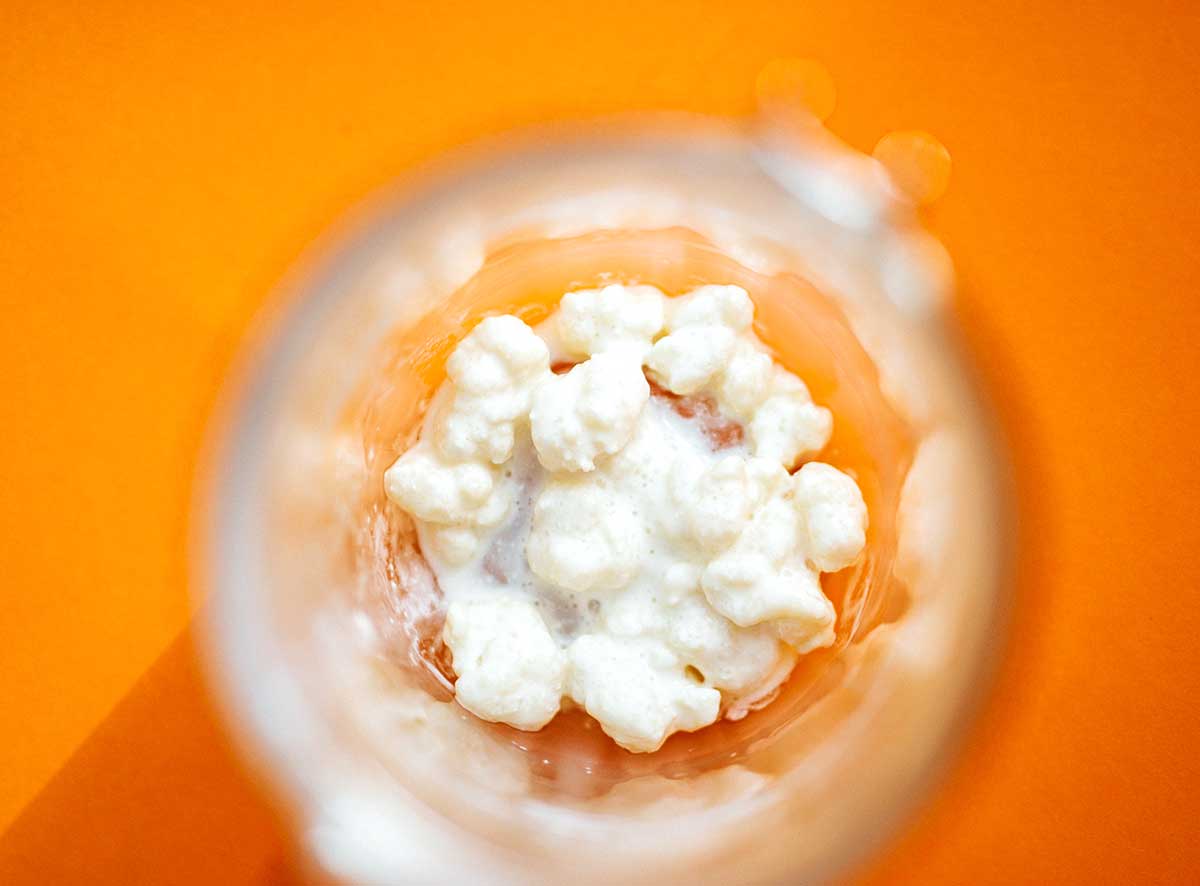
How to make your own kefir
- Clean: Clean everything well with regular soap (avoid antimicrobial soaps). I’m talking the hands, glass jugs, spoons, everything!
- Assemble: Add 1 Tbsp (ish) of the kefir grains and 4 cups of whole milk to a large glass jug. Cover the jug with either a few layers of paper towels or a few paper coffee filters. Secure with a rubber band to prevent any bugs or dust from getting in.
- Ferment: Set in a warm, dark spot (65 to 85°F / 18 to 29°C) for about 24 hours. You’ll know your kefir is done when it has slightly thickened and smells fermented. If you kefir has separated into yellowish watery-looking whey, that’s fine! It’s just a sign that you can either reduce the length of fermentation next time or use more milk next time.
- Strain: Place a wide non-metal bowl under a fine-mesh non-metal colander (a plastic colander is great here). Pour finished kefir into the colander, stirring with a plastic or wooden spoon to gently force kefir through. The grains will be left.
- Start new batch: Rinse out the large jar that you fermented the grains in, then add the grains back into it. Add 4 cups of fresh milk to start the process over again!
- Store fresh kefir: Transfer the finished kefir that collected in the wide bowl and transfer it to a sealable jar. Store in the fridge for around 2 weeks.
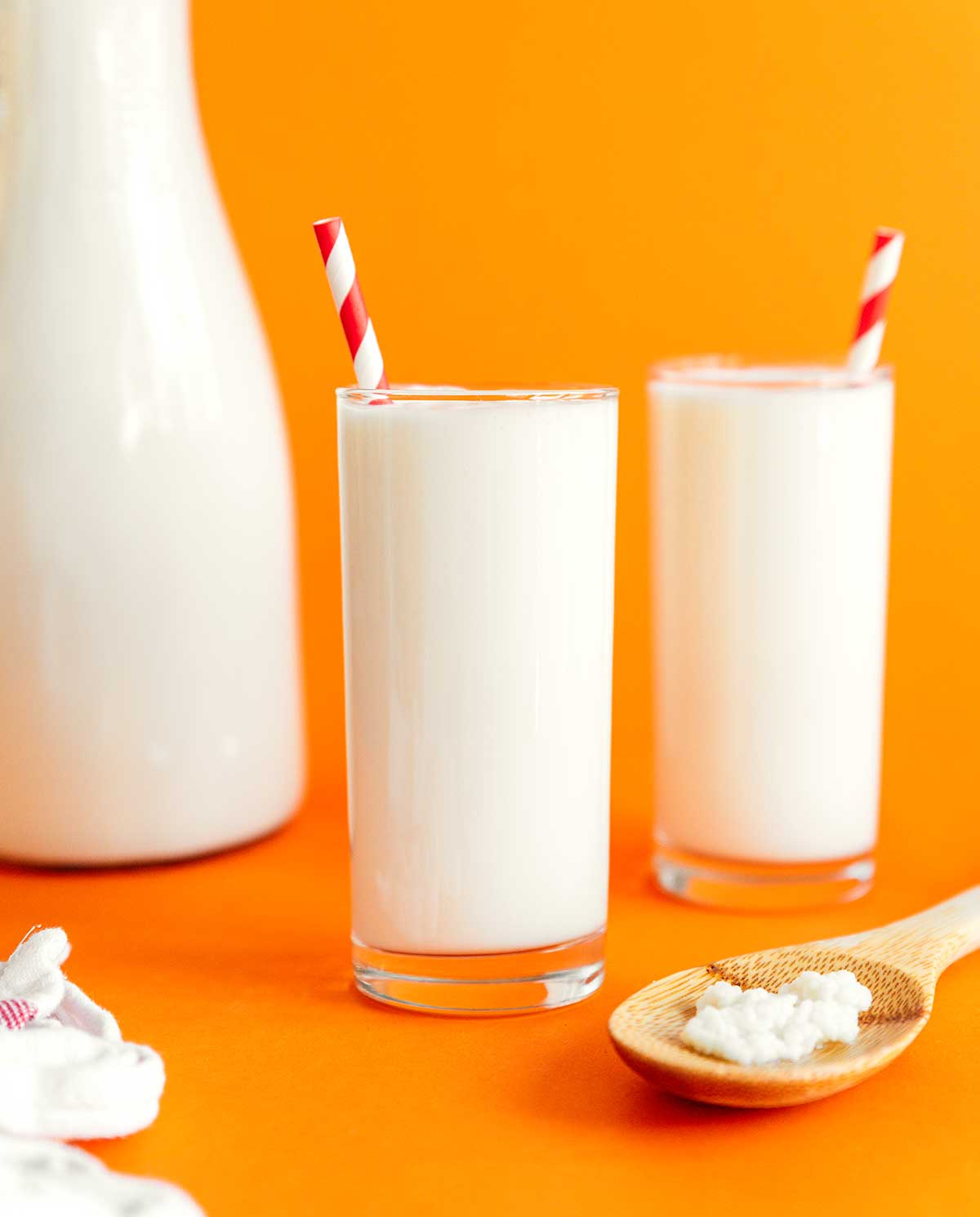
Homemade milk kefir FAQ
Give your kefir grains fresh milk, cover with paper towels or coffee filters as described, then set in the refrigerator. This dramatically slows down the fermentation process, so you will only have to change out the milk every 1 to 2 weeks (or when you see the milk separating into layers).
This is normal! When the milk separates into layers, it’s a sign that the kefir as “eaten” everything it can. You can prevent it by either reducing the time you let it ferment (ex: 18 hours instead of 24), or by giving it more milk. It depends on your grains, house temperature, and milk, so don’t worry if it takes a few batches to understand how your kefir will brew best.
Metals can hurt the microbial wonderland that is kefir. Avoid contact of the kefir with metal where possible (and definitely don’t brew the kefir in a metal vessel).
As with other fermentations, kefir is full of probiotics which promote good digestion and a healthy gut. The fermentation also breaks down a lot of the lactose in the milk, meaning kefir may be more easily digested than other dairy products for people with lactose intolerance.
Milk and water kefir are two different types of fermentations, using different ingredients and different kefir grains. You cannot use milk kefir grains to make water kefir.
Yes! 1 cup of kefir can be flavored by blending in fresh fruit (¼ cup), chocolate (1 Tbsp cocoa powder), vanilla (¼ tsp vanilla extract), or dates (1 pitted date).
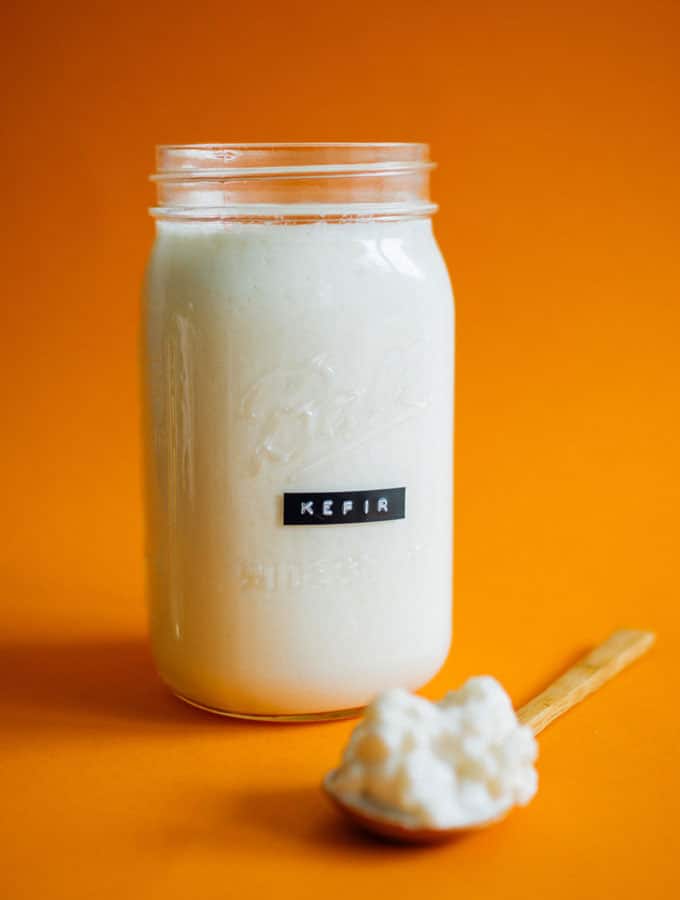
Ways to use kefir
Once you get going, you’ll likely find yourself with more kefir than you know what to do with! Here are a few of our favorite ways to use milk kefir.
- On its own: You can drink it, or use it in place of yogurt (like in a bowl of cereal).
- Flavored Kefir: Check out our guide for flavored kefir with fresh fruit (3 ways)!
- Smoothies: Use kefir in place of milk or yogurt to add a probiotic punch to smoothies.
- Salad Dressing: I love using kefir to make a tangy ranch dressing!
- Ice Cream: Creamy and rich, kefir makes a great ice cream! It takes on a taste like frozen yogurt.
- Baked Goods: Kefir makes a great substitute for buttermilk, so things like pancakes and biscuits are great with kefir!
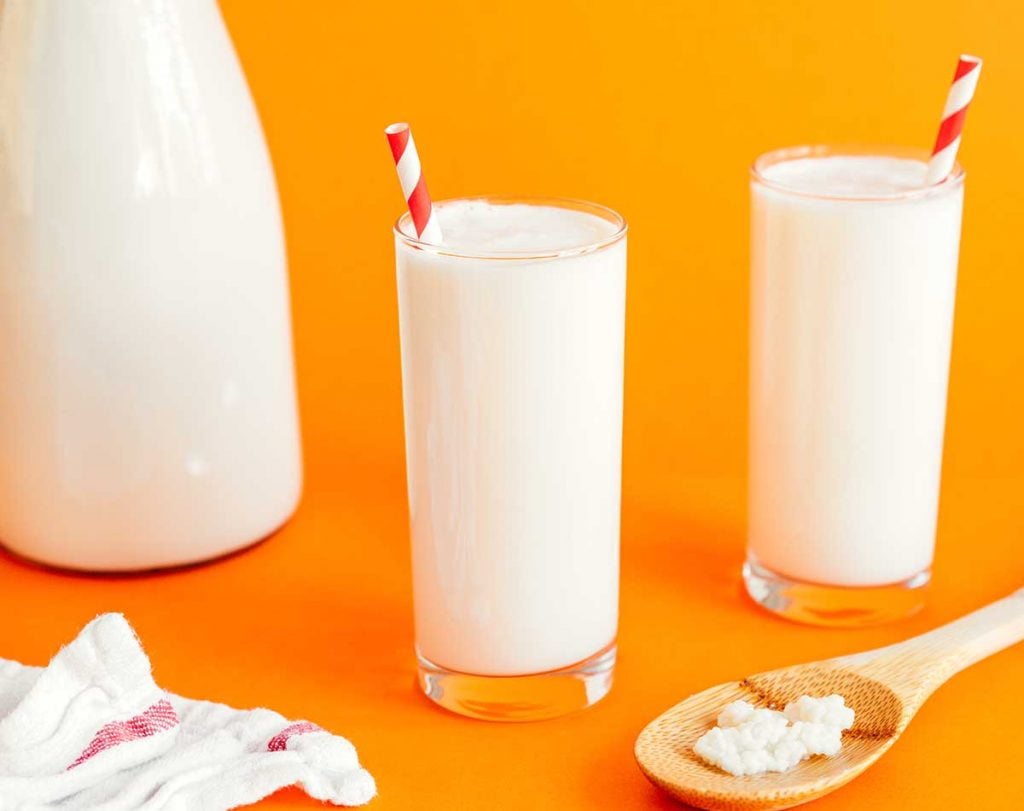
Be sure to try our other fermentation projects, like kimchi, Greek yogurt, tepache, and kombucha!
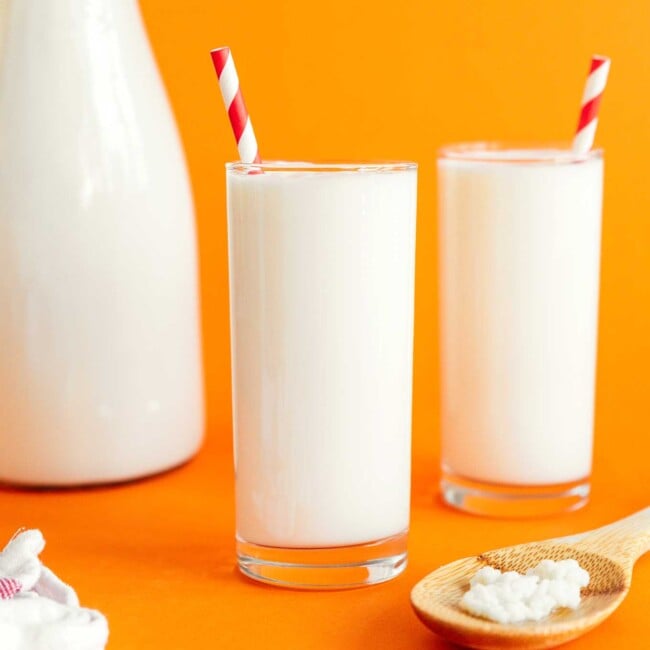
Ingredients
Ingredients
- 1 Tbsp kefir grains
- 4 cups whole cow’s milk 960 mL
Instructions
- Clean: Clean everything well with regular soap (avoid antimicrobial soaps). I’m talking the hands, glass jugs, spoons, everything!
- Assemble: Add 1 Tbsp (ish) of the kefir grains and 4 cups of whole milk to a large glass jug. Cover the jug with either a few layers of paper towels or a few paper coffee filters. Secure with a rubber band to prevent any bugs or dust from getting in.
- Ferment: Set in a warm, dark spot (65 to 85°F / 18 to 29°C) for about 24 hours. You’ll know your kefir is done when it has slightly thickened and smells fermented. If you kefir has separated into yellowish watery-looking whey, that’s fine! It’s just a sign that you can either reduce the length of fermentation next time or use more milk next time.
- Strain: Place a wide non-metal bowl under a fine-mesh non-metal colander. Pour your finished kefir into the colander, stirring with a plastic or wooden spoon to gently force kefir through. The grains will be left.
- Start new batch: Rinse out the large jar that you fermented the grains in, then add the grains back into it. Add 4 cups of fresh milk to start the process over.
- Store fresh kefir: Transfer the finished kefir that collected in the wide bowl and transfer it to a sealable jar. Store in the fridge for around 2 weeks.

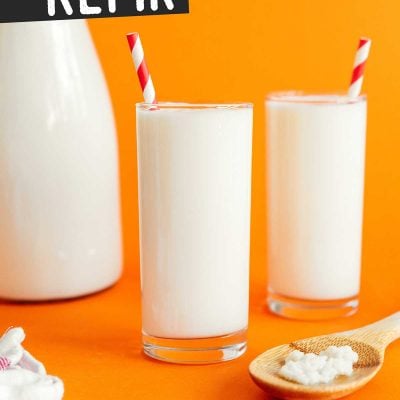
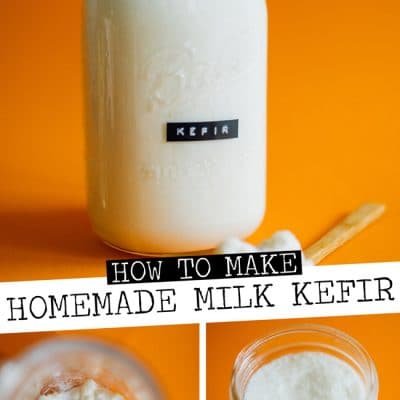

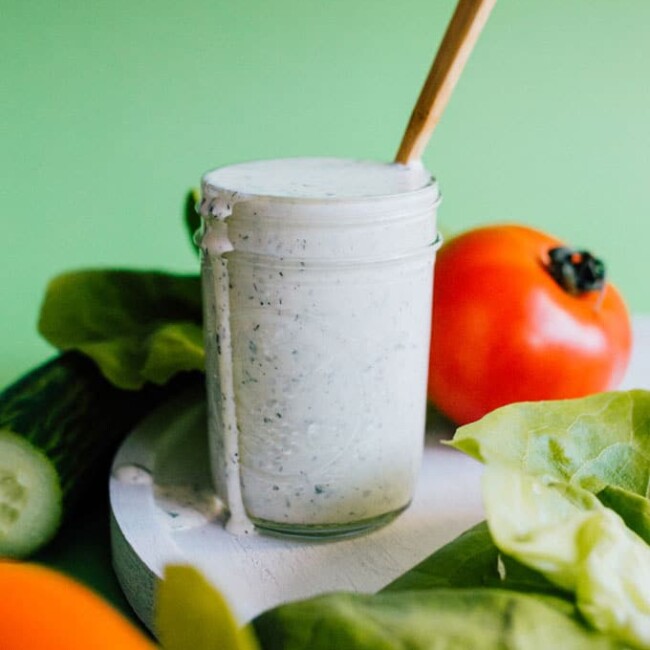
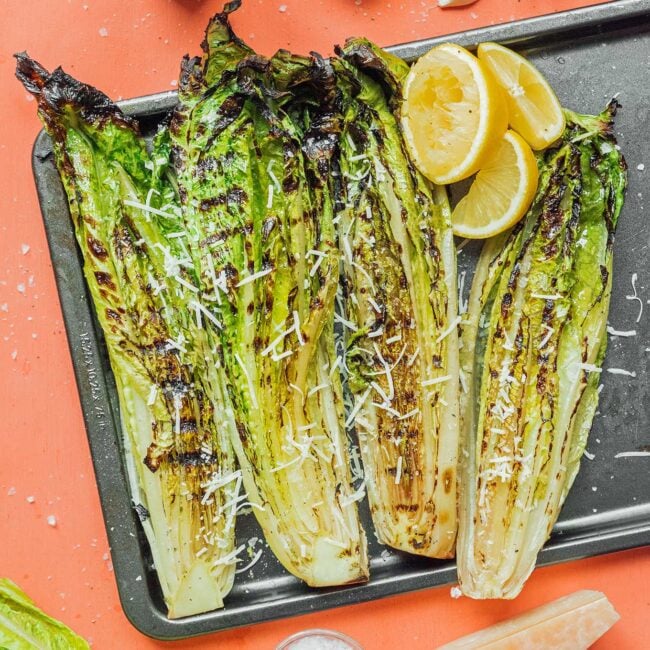
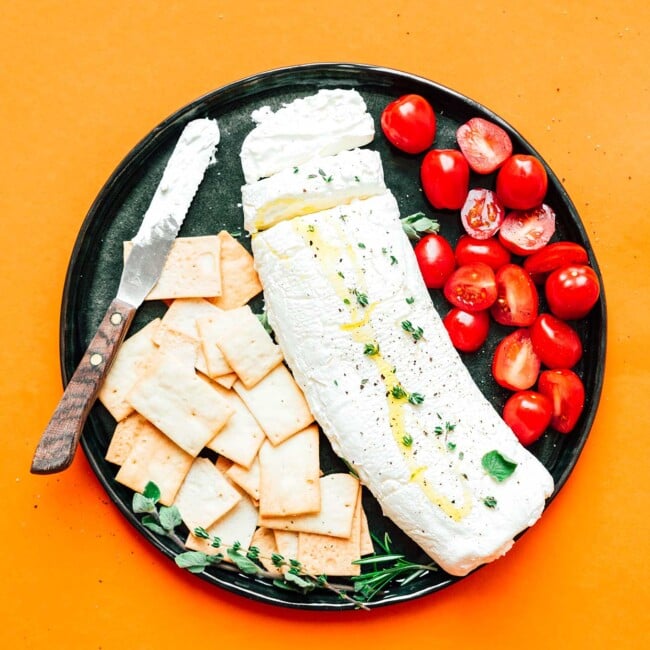
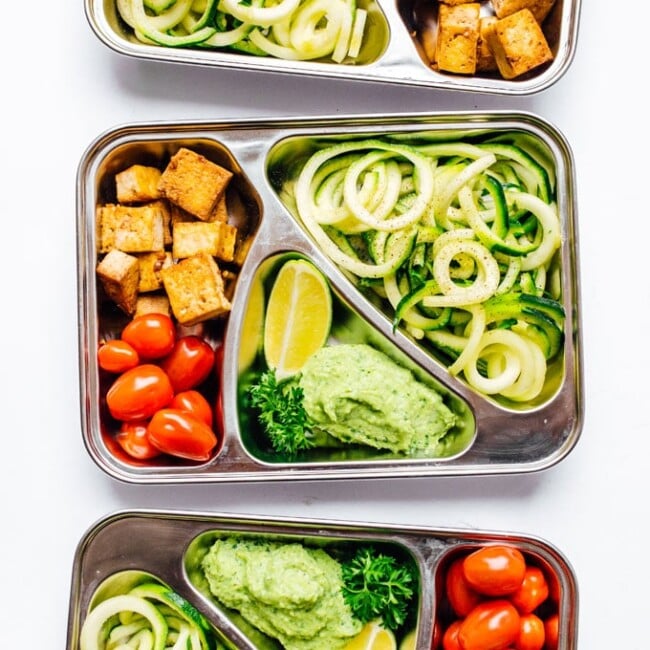
howard says
Worth giving Kermit the Kefir a bath in cold tap water every couple of weeks or so just to ensure that he doesnt get a layer of curd stuck round his outside. Every few weeks he will need dividing and throwing part away or giving it away lest he grows to an enormous size.You can freeze him if you are going away long term – wash him, pat him dry with kitchen towel, put him in a small pot with some dried milk powder and into the freezer. How long he lasts like that I do not know but he did 2 months for us.
ArPachon says
Very nice and easy to follow recipe; thank you.
Question: When is time to drink it? Once is done? after 2 weeks that is done and refrigerated? Could you please let me know?
Thank you for your time ant the courtesy of reading my email; I appreciate it.
Have a great weekend!
Sarah Bond says
It can be drank right after finishing the fermentation! I like to pop it in the fridge for a few hours to chill first though 😀
Barbara K says
I would expect lasts refrigerated at least as long as yoghurt, though probiotic value may diminish over time.
Patty says
I’m confused. Am I using 2 batches of 4 cups of milk, 8 cups total, or reusing the original 4 cups of milk?
Sarah Bond says
You’re using 4 cups for each batch!
Barbara K says
Thank you for your directions. I am new and hooked on making Kefir, both water and milk. Not sure if a placebo effect, but really have felt more energetic.
The milk Kefir so delicious and simple. My grains keep multiplying and can produce a quart in less than 24 hours. Can’t really go wrong except to over ferment causing to separate. Then strain out the whey and you have a lovely soft cheese. The whey is tasty, has probiotics also.
Jason Smith says
Better than any cream cheese from the store. Spread on a ritz cracker, maybe top with an olive, and you have a wonderful snack. Also, the whey that seperates can be used to lacto-ferment vegetables. Suaerkraut, ginger carrots, and kimchi are just a few wonderful things to ferment
Clarinda says
The kefir I made using a dollop of a friends starter is so delicious I don’t want to add other favors! Question: do you keep a few tbs of new kefir in the fridge for use as starter??
Sarah Bond says
You would typically need kefir grains to start the reaction, but if using that kefir as starter worked for you then I would definitely keep some in the fridge as future starter!
Nancy says
I’m new at making kefir and am confused about activating the grains. You put grains in jar with 4 cups milk and was able to drink next day. When I purchased my grains the instructions gave a several day process of gradually increasing amount of milk by 1/2 cup each time. Slowly feeding the grain. I had to start with 11/2 until I reached 4 cups before it was considered ready. What a pain!!! What is the difference that I had to go through that? Also, my seeds are very tiny they don’t look plump like yours.
Sarah Bond says
Hmm, maybe your grains are dehydrated or freeze dried and need to be activated over a longer period? Fresh grains shouldn’t require that process!
Knight says
I sure will try out this. I love your simple explanation, it makes it look so simple. Thank you
Andrea says
I’ve read on other sites about using other types of milk instead of animal milk. I’m looking to get away from dairy for awhile and wondered if you’ve ever tried to make it with any other types of milk like rice, soy or maybe even coconut?
Sarah Bond says
I haven’t tried other types of milk, so I can’t say for sure!
Geeta says
Hi. Thank you for sharing. Can I use ultra pasteurised milk? Also, what do I do with the extra grains that I get from each batch as they increase in quantity?
Sarah Bond says
You can use pasteurized milk yes! And you can gift them to friends or make even more kefir!
Alison Paulin says
Hi Greta, You can not use ultra pasteurized milk, it will not work. You can use ordinary, pasteurized milk.
Joss says
My kiefer seems to look like curdled milk when done. Is this normal?
Sarah Bond says
Yes it does look a bit like that! As always use your best judgement – it should taste sour but not spoiled.
Yvonne says
I would like to make my own milk kefir grains from scratch but can’t find info on how to. Seems that everyone buys them or gets them from others. Just like a sourdough starter, it seems to me that it should be possible to make the grains yourself.
Sarah Bond says
It’s generally a bit harder to make kefir grains than with other fermentations (like kombucha SCOBYs or sourdough starter). This is because most store bought kefir is made from powdered milk, and it isn’t quite as “alive” as starter from an existing home batch would be.
Anne Fraser says
How long can you keep using the same kefir grains ? Can you use some of the homemade kefir as a starter for a new batch?
Sarah Bond says
You can use them indefinitely! They keep growing and regenerating, so they’ll work as long as you are giving them fresh milk. The kefir grains should be the starter for each batch though, not the actual kefir.
Rick says
I make my own sourdough bread, is it possible to use Kefir as an ingredient in the bread in place of the normal milk and if so will it kill its properties during the baking process? Many thanks, Rick.
Sarah Bond says
It should be possible, yes! But indeed, high heat will kill many of the probiotics.
Amber rose says
Hello! I’ve made kefir before but couldn’t keep up with it. We used it but not as much as it produced lol. Do I have to use so much milk or can I reduce it? Also, how do you start it when you aren’t using it?
Sarah Bond says
That’s the tough thing about kefir! If you use less milk it will just ferment faster. If you want to put a pause on it, let it ferment for few days at a time and change out the milk every so often.
Jessica says
Hello, I’m curious why metal bowls, spoons, strainer are not to be used? This is all I really have in my kitchen (aside from wooden spoons). What affect does the metal have on the kefir?
Sarah Bond says
The acidity of the kefir and react with the metal in the bowls. If that’s all you have you can use these for brief contact, but it shouldn’t be exposed longterm to metal (i.e. the actual fermentation should take place in glass).
Irene Karsh Hughes says
Can this be made in smaller batches?
Sarah Bond says
Yes! Just scale down the grains and milk 🙂
Jean Finch says
When you have existing kefir can you give it a boost with raw kefir?
Sarah Bond says
I don’t see why not!
Jane says
Must I use pasteurized milk first then switch slowly to raw milk if I’m using kefir grains from the wife of the farmer from where I get my raw milk?
Sarah Bond says
If it started on raw milk you could probably continue using it!
Isabel says
Hi Sarah,
I found your blog, it is great write up about Kefir!! Thank you!
Sarah I have a question, I put my kefir to ‘sleep’ for almost two weeks, I could keep up drinking all my kefir and didn’t know what else to make or use it in it… I have a question, the ‘kefir’ product that was fermented for those two weeks is it safe to drink it?
thank you kindly for your answer in advance
Sarah Bond says
As long as there are no signs of mold it should be safe to drink! It may just be a bit tart.
Sylvie says
Hello! I started my first batch of kefir on March 28th with approx. 1 tsp of milk kefir grains and approx. 3 cups of homogenized milk. But it still smells only like milk and has not thickened. It does not smell fermented. I can see the curds on top of the milk. No seperation as of yet either. How much longer should I leave it on the counter?
Sarah Bond says
The process should be pretty quick, just a few days. You have it out at room temperature? I might try again with different grains.
Hope says
Really want to try this! Why can’t I use a metal sieve to strain the kefir? Just wondering because the recipe calls for a non metal one.
Sarah Bond says
You want to minimize exposure to metal where possible because the acidity of the kefir can cause those metallic flavors to transfer in.
Weary says
You can actually just buy a bottle of store kefir, and pour about 1/2 – 1 cup into a store bought 3 pint plastic bottle of milk. Once your first batch works, just get buying milk, and pouring a half cup of your own kefir in a fresh bottle of milk. Once its working, your kefir will work better than the store bought stuff. Put a cloth towel and rubber band around the top while it is brewing. No need to wash or clean anything this way.
indigo schneir says
Do the milk/kefir grains go bad when left out for fermentation?
Sarah Bond says
They could, but they should be find for a few days! Best to keep them in kefir though.
Veronica says
Can I ferment it by putting it in the over at the mentioned temperature?
Sarah Bond says
Yes that could work, especially if it’s cold where you are!
Dee says
Hi, many thanks for your clear instructions.We have a simple old ,but effective yoghurt maker, for ease could I just put the just use this?
Kind regards,
Dee
Sarah Bond says
I think that would work! Kefir doesn’t need to be quite as warm as yogurt, in my experience, so it might just ferment more quickly.
steve says
Hi, I ordered milk kefir grains on Amazon. They are cultures for health kefir grains. My second batch turned blue. Can you please explain why, and is it mold? I had only fermented for 20 hours and replaced with fresh cow milk. Clean jar with a jar lid.
Sarah Bond says
That does sound like mold to me unfortunately. Is it nearby any other fermentations?
Steve says
No, not near anything else. I didn’t think mold could grow in just 20 hours?
Sarah Bond says
Does it have a circular pattern and fuzzy appearance?
Steve says
Is a circular pattern.
Sarah Bond says
That does indeed sound like mold then. If it’s warm where you are the fermentation might have just gone super quickly? Or perhaps it was contaminated from the start?
kåre says
hi.
is this regular kefir or some kinda variation? the reason i ask is that you got it from a brewer and i dont see why a brewer would have anything to do with kefir. so i think this might be a different type.
thanks,
Sarah Bond says
This is normal kefir! I got that grains from a kefir home brewer 🙂
Bonnie says
HELP! You make it look and sound so simple and yet I am still struggling. Is the finished product supposed to taste cheesy or am I letting it go too long? I once left it on my counter for 24 hours . . . it separated and I spent 20 minutes separating the grains from the curds. (I have been using raw milk)
Sarah Bond says
Raw milk could be your issue, because there’s a lot of “wild” bacteria in there that could be interfering! It should taste a bit sour and creamy, but I haven’t got cheesy before. (If you’re unsure, try buying a bottle of kefir and using that as your taste reference!)
Margaret says
I have been making this since last spring and love it. When I go out of town I just put it in the fridge and then when we get home I can take it our, set it on the counter for 24 hrs and I’m good to go. I’ve done this multiple times and it’s always worked perfectly.
However, the last time I did this it didn’t seem to work. I am getting sour milk now but nothing like what I had before. Also, some that I had in the fridge ready to make a smoothie with is runny and tastes like sour milk. (In the past it has gotten thicker the longer I left it in the fridge.)
Help! What have i done wrong? And how do I get back to my delicious Kefir?
Thanks in advance for your advice.
Sarah Bond says
In my experience, putting the fermenting kefir in the fridge has caused the fermentation to stop (for me that led to mold, but it sounds like in your case it led to the cultures getting weak). I haven’t found a great solution, but I think it would be happier at room temp with plenty of fresh milk before you go!
emilia says
My kefir grains came with instructions to “activate” them by soaking in 1 cup of milk for 12+ hours initially, then continuing to transfer to new milk, and adding 1/2 cup each time, for 7 batches (4 cups). However, it’s hour 19 and the milk hasn’t thickened to a heavy cream consistency yet which is when the instructions say to move to new milk…and all the recipes I see online are like this one- a one-and-done method of soaking! I wish I’d checked here first instead of following the package directions! Should I keep going with what I’m doing? How long is too long for the initial soak? Can I add more milk now and just wait longer without doing the “activation” process? Any advice would be appreciated…
Sarah Bond says
That method sounds like it should have worked. Make sure you’re fermenting somewhere that’s warm and away from direct light! It should start to thicken and smell tart soon.
Judy Crosby Davis says
I followed the recipe, left out on counter for 24 hours, strained it, and it’s not very thick or sour. I used whole milk and can’t decide if I should try leaving it out longer (not sure I can try with the same milk as it’s been in the fridge) or should I just start over from scratch with the grains I have. A friend gave me the grains. My milk was ultra-pasteurized. Does that matter?
Sarah Bond says
The ultra pasteurized milk should be okay for making kefir, so I’m not sure why it wouldn’t be working. It definitely sounds like a fermentation is not happening, I wonder if the grains are healthy enough? It could also be too cold in your kitchen and may just be fermenting very slowly.
Hillary says
Can I use 2% milk or 2% lactose free milk. Also can I make half the quantity at a time? Thank you in advance. Keen to get started.
Sarah Bond says
2% milk will work but I’m not sure about lactose-free milk. And yes, you can scale the recipe up or down as needed!